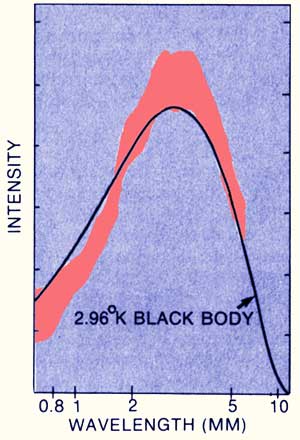
| |
 |
Cosmic
Microwave Measurements
|
 |
|
| Theorists
calculate that a colorless "black body" at a temperature three degrees above absolute zero emits radiation whose intensity peaks at a wavelength just above 1 mm (solid line). Penzias and Wilson’s one point fell near this curve. Within a decade, scientists had measured more points (open circles) and upper limits (solid circles) |
||
 |
||
| In
1975, balloons above most of the atmosphere roughly measured infrared radiation
(pink area), proving that the cosmic radiation follows the curve. More recently, satellite measurements traced the curve with great precision. Credit: Both images from CONTEMPORARY ASTRONOMY 2/E 2nd edition by PASACHOFF. © 1981. Reprinted with permission of Brooks/Cole, a division of Thomson Learning: www.thomsonrights.com. Fax: 800-730-2215. |
||
Copyright ©. Brought to you by the Center for History of Physics, a Division of the American Institute of Physics |
|
|||||